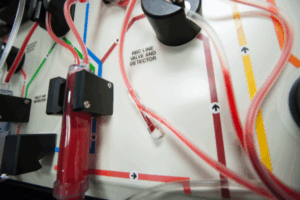Oncology
Mantle Cell Lymphoma
Prognostic Variables of Progression-Free Survival in Mantle Cell Lymphoma After Autologous Stem Cell Transplantation
Overview
A significant proportion of young and fit patients with mantle cell lymphoma (MCL) experience long-term disease control after intensive induction therapy and autologous stem cell transplantation (ASCT). However, not all patients are likely to benefit from such an approach. A number of clinical and biologic prognostic factors are associated with inferior outcomes after ASCT, including the presence of TP53 mutation.
Expert Commentary
Anita Kumar, MD
|
|
“If we identify a patient with MCL and a TP53 mutation, we do not recommend upfront ASCT. These patients might be considered for frontline trials exploring novel agents.”
For younger, fit patients with MCL, one of the leading standards of care is treatment with intensive induction chemotherapy, including cytarabine-based therapy, followed by high-dose chemotherapy and ASCT. This is typically followed in remission by rituximab maintenance therapy for up to 3 years. Upfront transplant can offer appropriately selected patients excellent outcomes. Retrospective analysis at our own institution between 2000 and 2014 showed that upfront SCT was associated with a median progression-free survival (PFS) of more than 7 years and a median overall survival (OS) of more than 13 years; and, it is possible for some patients to be in remission for decades after this approach.
A key question is, then: How do we identify those patients who stand to benefit? A variety of prognostic variables have been considered in this context. Age is an important factor that is represented in the Mantle Cell Lymphoma International Prognostic Index (MIPI). The MIPI is a robust prognostic tool shown to be of value in predicting survival, and includes age, but also performance status, serum lactate dehydrogenase, and white blood cell count. These 4 factors help to identify high-risk patients who seem to have a shorter PFS and OS after ASCT. Additionally, the MIPI can be combined with another very important prognostic variable, the Ki-67 proliferation index. The Ki-67 score has been recognized as a strong biologic prognostic factor in MCL. Patients with a Ki-67 scores that are less than 10% tend to have more favorable outcomes, and those with Ki-67 scores that are greater than 30%, and particularly greater than 50%, tend to have a shorter PFS after ASCT.
Morphologic characteristics of MCL may have prognostic value, and a subgroup of patients with high-risk histologic features (ie, blastic morphology, blastoid morphology, pleomorphic morphology) tend to do poorly after ASCT. Genomic sequencing is also important, as TP53 mutation has been associated with inferior outcomes after ASCT. Eskelund et al published a very important analysis in which they pooled data from younger patients with MCL from the Nordic MCL2 and MCL3 trials. TP53-mutated patients had a median OS of 1.8 years, and 50% relapsed at 1.0 years, compared with a median OS of 12.7 years for TP53-unmutated cases. If we identify a patient with MCL and a TP53 mutation, we do not recommend upfront ASCT. These patients might be considered for frontline trials exploring novel agents.
Finally, minimal residual disease (MRD) testing is emerging as an important prognostic feature in patients with MCL. Patients who are MRD positive prior to ASCT do worse than those who are MRD negative.
References
Chumetski MC, Switchenko JM, Goyal S, et al. Prognostic variables of progression free survival in mantle cell lymphoma after autologous stem cell transplantation. Biol Blood Marrow Transplant. 2019;25(suppl 3):S23-S24.
Delfau-Larue MH, Klapper W, Berger F, et al; European Mantle Cell Lymphoma Network. High-dose cytarabine does not overcome the adverse prognostic value of CDKN2A and TP53 deletions in mantle cell lymphoma. Blood. 2015;126(5):604-611.
Eskelund CW, Dahl C, Hansen JW, et al. TP53 mutations identify younger mantle cell lymphoma patients who do not benefit from intensive chemoimmunotherapy. Blood. 2017;130(17):1903-1910.
Kumar A, Sha F, Toure A, et al. Patterns of survival in patients with recurrent mantle cell lymphoma in the modern era: progressive shortening in response duration and survival after each relapse. Blood Cancer J. 2019;9(6):50.
Le Gouill S, Thieblemont C, Oberic L, et al. Rituximab maintenance after autologous stem cell transplantation prolongs survival in younger patients with mantle cell lymphoma: final results of the randomized phase 3 LyMa trial of the Lysa/Goelams group. Blood. 2016;128(22):145.
Martin P, Ruan J, Leonard JP. The potential for chemotherapy-free strategies in mantle cell lymphoma. Blood. 2017;130(17):1881-1888.











